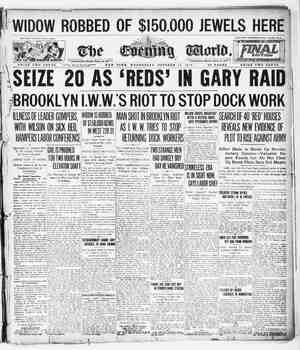New Britain Herald Newspaper, October 15, 1919, Page 5
You have reached the hourly page view limit. Unlock higher limit to our entire archive!
Subscribers enjoy higher page view limit, downloads, and exclusive features.
NEW BRITAIN DAILY HERALD, WEDNESDAY, OCTOBER 15, 1919, Native workers setting out rubber tree seeds in a plantation ‘‘sursery’’. When the rubber trees reach a height of four cr five feet they are transplanted to permanent Sfields where they mature in about six years. Mazny people believe that yubber heels are made by pouring liquid rubber into moulds. This is not the case. The heels are stamped out of rubber dough pr ‘‘com- pound’ in thé exact size to fit the moulds. Then they are put into the moulds and baked under pressure. Rubber is not always resili- ent. Any man who has ever broken a pipe stem knows Just how hard and brittle rubber can be. As prepared for the pencil eraser, rubber is soft and crumbly. Its resiliency is and it wears cway is mixed o Many methods of tapping ruvber trees are employed by different growers. Probably the most scientific is the her- ringbone method used by this native girl 10 extract the milky juice from the tres. On plantations the milky juice of theryb- ber treeis coagtfared, s or congealed, in fsyge - vats by means of o V weak acid. his process of removing thewater has largely superseded the more primitive method of smoking the Auid over fires made of balm nuts, After rubber is skim- med from the congeal- ing vats it is dried thoroughly before be- ing baled or boxed for shipment. Plantation rubber reaches the rubber manufacturer practically pure. / . Rubber for your nd:bahedaylihe bread The sSPRINGINESS and DURABILITY of a rubber heel depend on the pouGH, or “COMPOUND" UST as good flour is necessary to make good bread, so only good quality rubber will make good heels. But good bread depends upon more than.good flour—it depends on the dough, or the mixture of flour with other ingredients. It is the same with rubber heels. Rubber itself 1s an elastic, resilient substance derived from the milky juice of certain tropical trees. In its crude state it is not at all suited to practical use. Heat and light are its natural enemies. It becomes soft and tacky in hot weather and stiff and brittle in cold. Only by mixing it with other ingredients, and then “‘curing’” or baking it under pressure can rubber be made really useful. Why “compounds” differ The mixing or ‘“‘compounding” process is not the same, however, for all articles made of rubber. Each of the 30,000 dif- ferent rubber products in use today must have individual characteristics to meet the use for which it is intended. One must be hard as in pipe-stems and combs, another soft and spongy as in pencil erasers. One must endure steady pressure, another continuous pounding. Still others thust withstand the grind of abrasion. The final character of any rubber article depends upon its ‘“‘compound”. In per- fecting the ‘“‘compou’’ the rubber chem- ist works backward. He first determines the use to which the article will be put, and the work it will have to do. Then he chooses from among a hundred varieties of rubber and thousands of compounding ingredients until, by experiment, he has established the correct “compound” for the required use. N Why O’Sullivan’s Heels have so much “life” O’Sullivan’s Heels—now universally rec- ognized asa practical necessityof cityliving conditions—put an exacting demand upon the “‘compound”’. O’Sullivan’s Heels must have both resiliency and durabilitv— the springiness to endure continuous pounding, and the toughness to withstand daily grinding on hard pavements, The ditterence between ordinary rubber heels anid O’Sullivan’s Heels If an O’Sullivan Heel is cut along the side, as shown at the right, so that a thin strip of rubber is left attached at one end, that strip will have great elasticity—it can be stretched several inches. With an ordinary rubber heel the material snaps in two before it has stretched to any great degree. This test proves the remarkable resiliency and durability of O’Sullivan’s Heels. O’Sullivan’s Heels Copyrighted, 1919 by C'S. R. e, T eAbsorb the shocks that tire you out s To secure the resiliency and durability of O’Sullivan’s Heels the highest grades of rubber are combined, by a special proc- ess, with the best toughening agents known. The “compound” is next rolled into long strips and the heels stamped out just as bisenits are cut. Then the heels are placed in :roulds and baked in vulcan- izing presses the exact length of time to effect the “cure”. It is this special process of mixing and baking that has, since the making of the first rubber heel, established O’Sullivan’s Heelsasthestandard of rubberheel quality. Guaranteed to outlast 4. any other heels %fi O’Sullivan’s Heels are guaranteed to ' wear twice as long as ordinary rubber heels; and will outlast three pairs of leather heels. Go to your shoe repairer today and have O’Sullivan’s Heels put on your shoes. O’Sullivan’s Heelsare furnished in black, white or tan; for men, women and chil- dren. Specify O’Sullivan’s Heels, and be sure that you get O’Sullivan’s—avoid the disappointment of substitutes.{






